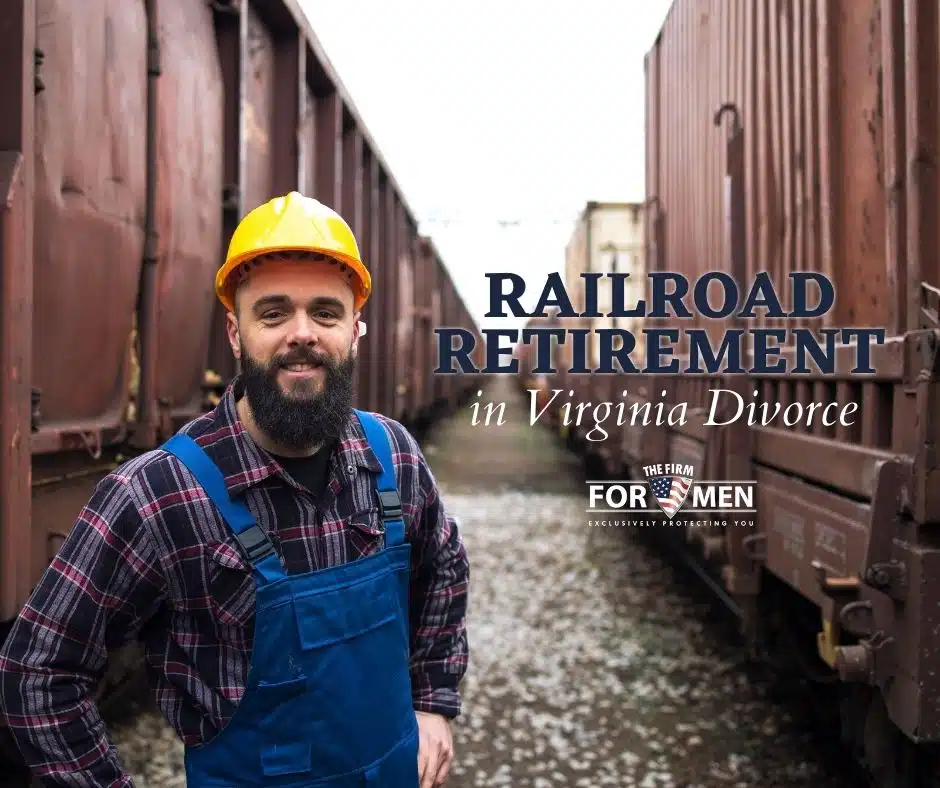Virginia is home to 5,267 railroad employees working on some 3,000+ miles of track for nine freight railroads and at least three passenger lines, according to RailServe.com. That means some of those folks working on the railroad will retire from their careers, and, possibly, divorce.
Jump to a Section
- Railroad Retirement Act (RRA) Pensions
- Are Railroad Retirement Benefits Divided in Divorce?
- Meet The Supremacy Clause
- Calculating Divisible and Non-Divisible Benefits
- Benefit Requirements
Railroad Retirement Act (RRA) Pensions
Railroad employees are protected by the Railroad Retirement Act (RRA). RRA pensions are overseen by the U.S. Railroad Retirement Board (RRB). Benefits accrued under the RRA (and managed by the RRB) are better than benefits from Social Security.
The RRB highlights several of these advantages, the most important of which is higher monthly retirement benefits—an average of $3,045 a month for railroad retirement versus an average of $1,500 a month for Social Security.
This provides plenty of incentive for a spouse to seek an equitable portion of those benefits in divorce. Any railroad employee contemplating divorce needs to work with an experienced divorce attorney to safeguard those benefits, which are more than twice the typical Social Security benefit.
Are Railroad Retirement Benefits Divided in Divorce?
Railroad retirement is unique. The RRB is under the aegis of the executive branch of the federal government, just as is the Social Security Administration. But, unlike Social Security benefits (which can be divided as tangible assets in a Virginia divorce), only some railroad retirement benefits can accrue to the ex-spouse of a railroad employee. A major portion of a railroad worker’s retirement benefits are not subject to equitable division.
Meet The Supremacy Clause
The Supremacy Clause of the U.S. Constitution dictates that federal laws outweigh state laws, contract law, and local statutes. This matters with railroad retirement funds because of its two-tiered system under federal law:
- Tier I benefits are not subject to property division
- Tier II benefits are subject to property division
Some attorneys may attempt to include language in property settlement agreements or divorce decrees mandating a court to divide (partition) all components of railroad retirement equitably. We will let the RRB’s Office of General Counsel respond:
“… a court cannot mandate entitlement to an auxiliary annuity [meaning annuities for spouses, divorced spouses, and survivors]. The RRB will disregard any attempt by a state court to award the divorced spouse annuity…”
We are not saying your spouse’s attorney would deliberately attempt to ignore federal law. We are not saying a state court would purposely try to destabilize your financial future. Many attorneys are not familiar with the railroad retirement system and may be unaware their clients are not entitled to equitable distribution of the entire pension. Some state courts may simply rehash language used in other divorce decrees without knowing the particulars of railroad retirement.
You need an experienced family law attorney to provide enlightenment in such matters.
Also out of bounds with railroad retirements: the Employment Retirement Income Security Act (ERISA), a federal law setting minimum standards for most retirement and health plans in private industry. The RRB only accepts a Qualified Domestic Relations Order (QDRO) if its wording allows for equitable distribution in line with RRB’s regulations.
Calculating Divisible and Non-Divisible Benefits
Tier I (non-divisible) benefits are calculated so that the employee receives the same benefit amount as a Social Security benefit would provide, were the employee covered by the Social Security Act (SSA). A railroad employee’s Tier I benefits can be calculated from both railroad employment and employment covered by the SSA.
Tier II (divisible) benefits are calculated only on earnings within the railroad industry. Additional benefit components that can be equitably divided:
- Supplemental Annuity—Applicable for railroad employees working before 1981 and with 25 years of service
- Vested Dual Benefit—For railroad employees meeting specific vesting requirements
- Overall Minimum Increase—An amount added to a pension to make it equal to Social Security benefits
Benefit Requirements
For an ex-spouse to be eligible to receive any part of Tier II and other benefits, the RRB requires three things:
- The marriage must have lasted at least 10 years
- Both the railroad worker and ex-spouse must have reached age 62 for a full month
- The ex-spouse is unmarried
To protect a railroad worker’s rights and financial future, an alert, attentive family law attorney is a must. The attorney needs to be familiar with the ins and outs of the RRA, RRB, and the SSA.
Whether you work for a niche heritage industry like America’s railroads or for the aerospace sector, your rights deserve to be protected. Contact us today at The Firm For Men or telephone us at (757) 383-9184. We help Virginia’s men in all aspects of family law.

